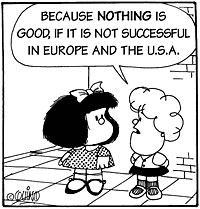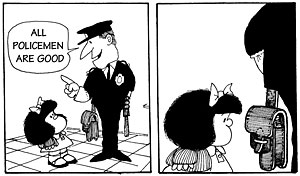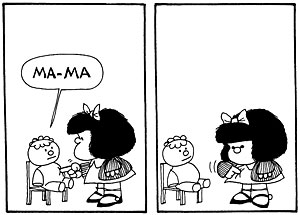>> Beyond Borders: Mondo Loco
>> Beyond Borders: Every Picture Tells A Story
More...

Children are innocent.
Well, not really. The little bastards can be pretty evil. But despite that, children have been used as a symbol of purity through the centuries, perhaps because children have a knack for raising inappropriate questions and stating their thoughts without duplicity or second thought. They simply say what they feel like saying, whenever they feel like saying it. It's a trait that's been employed by artists of all kinds, to take an uncompromising look at the adult world.
Enter Joaquín Salvador Lavado, aka Quino, maybe the greatest cartoonist ever, who used children to raise the most inappropriate questions at the most inappropriate of times.
Quino was born in Mendoza, Argentina in 1932. Born of Andalusian immigrants, Quino studied fine arts, but soon quit to pursue his passion - writing and drawing funnies for the papers.
It was not an easy task. Argentina back in the 50s and 60s was a mess. A country suddenly blossoming, quite like the US in the last decades of the 19th century, Argentina was seen as a land of opportunity, with ships loaded with European immigrants landing in search of hope every day.
 The immigration massively helped the economy, but also created great concentrations of poverty, which agitated the nation's political landscape. There was coup after coup,with fragile and brief democratic governments in between, the CIA flashing her dirty parts, Communist guerrillas running around like headless chickens, populist Goebbels wannabes... to call it volatile would be an understatement.
The immigration massively helped the economy, but also created great concentrations of poverty, which agitated the nation's political landscape. There was coup after coup,with fragile and brief democratic governments in between, the CIA flashing her dirty parts, Communist guerrillas running around like headless chickens, populist Goebbels wannabes... to call it volatile would be an understatement.
But somehow, the middle class still managed to flourish, allowing an avid interest in the arts and a free press. It was an interest that fuelled a comic industry and allowed people like Oesterheld, the Breccias, Carlos Trillo, Enrique Barreiro and many others to create works that can be rated as nothing less than masterpieces.
Quino had his first work published in 1954, in the magazine Esto Es. At first, he used silent cartoons, mostly one panel vignette gags of pure slapstick, but as his fame grew, he introduced dialogue and also shifted the tone of his strips. He left behind the light comedy and started concentrating on satire, mixing social and political commentary, in spite of all the dangers that such a line of work posed in the powderkeg environment of Argentina. (As explained in the first Beyond Borders article, cartoonist HG Oesterheld was killed by the military for daring to raise his voice.)
With time, Quino's work became more and more famous, and he published his first volume of collected work, MUNDO QUINO, in 1963. It was that same year when he devised the character that would bring him fame beyond Argentina: Mafalda.
The genesis of the project, as sometimes happens, owed a lot to luck and coincidence. An advertising agency looking for a cartoonist to illustrate an ad for an electronic appliance company asked Quino for a strip in the style of PEANUTS and BLONDIE, with a central character whose name started with M, to match the company's name.
 Quino devised Mafalda, but the company didn't run the ad, so Quino retained ownership of the character. And thank God for that, because one year later, Quino decided to make Mafalda the star of her own newspaper strip. It was a success unlike any the country had ever seen before, leading to reprints, trade paperbacks, TV shorts, foreign licenses, a merchandising empire... You name it, Quino did it.
Quino devised Mafalda, but the company didn't run the ad, so Quino retained ownership of the character. And thank God for that, because one year later, Quino decided to make Mafalda the star of her own newspaper strip. It was a success unlike any the country had ever seen before, leading to reprints, trade paperbacks, TV shorts, foreign licenses, a merchandising empire... You name it, Quino did it.
Though Charles Schulz' PEANUTS had some influence on MAFALDA, Quino was very much his own man, and Mafalda was very much her own girl. After all, the adventures of Snoopy and friends are really very harmless. Though Schulz burdened his characters with philosophical insight and invited his readers to empathise with his cast, to more cynical audiences PEANUTS can seem toothless, tame and feeble. Which is quite the opposite of MAFALDA.
The cast of Mafalda were primarily children, all given distinct personalities and character traits that mimicked those of their parents. Through these children Quino could explore ideas and situations from the real world, but because they were children, they enjoyed rather more freedom of expression than their adult counterparts. In the strips starring the parents, the tone is usually sweeter, the themes mundane. When Mafalda and her friends take the spotlight, the tone changes, and the eight year olds express their feelings on corruption, poverty, the military and the state of the world affairs loudly and clearly.
Mafalda embodies the spirit of the youth of 1968 Paris, the spirit of revolution. She is rebellious, poignant, idealistic, and pissed off with how the world is, appealing to the reader to acknowledge the situation and to work to change it. But the strip is also very funny, almost hysterically so - another thing that separates it from PEANUTS.
By 1973 there were nine MAFALDA volumes, all of them unanimously praised by both critics and the public. Later the strip debuted in Germany, France and Portugal and many other countries around the world. But suddenly, surprisingly, Quino stopped the strip.
 Why? The author has always refused to answer. Many critics have argued that maybe he felt overshadowed by his own creation, or that he sensed the political climate was getting darker and darker, with the radicalisation of Perón's politics and the shadow of a military junta looming on the horizon, but the ultimate reason is still unclear.
Why? The author has always refused to answer. Many critics have argued that maybe he felt overshadowed by his own creation, or that he sensed the political climate was getting darker and darker, with the radicalisation of Perón's politics and the shadow of a military junta looming on the horizon, but the ultimate reason is still unclear.
In 1976 the generals performed a coup and Quino left the country for Italy. One year later he briefly returned to his most famous character, to illustrate the International Edition of the World Campaign for the Declaration of Children's Rights. Other than a couple other charitable efforts, these would be the last Mafalda strips. But Mafalda remains a recognisable icon in every country where her books were published. She is probably one of the most popular fictional characters in the world.
Yet she's almost completely unknown to the English market.
Recently Quino toured the US in search of a publisher, and was rejected by several editors. One publisher allegedly declared that the strip was "too sophisticated" for American children.
Thankfully, someone decided to step in and put an end to this lunacy. In a bold move, Quino's Argentinean publisher, Ediciones La Flor, released an English edition of the first MAFALDA collection in April 2004. With three more volumes already published, and that first volume on its third reprint, it seems safe to say that the strip is finding its audience.
There's still very little awareness of Quino or MAFALDA in the English-language comics market, though, which is a crime. This is one of the most important comics ever created, and it's finally available for the English-speaking world to enjoy. It would be a great shame to miss out on it.
You can find out more about Quino at the Club Cultura website.

This article is Ideological Freeware. The author grants permission for its reproduction and redistribution by private individuals on condition that the author and source of the article are clearly shown, no charge is made, and the whole article is reproduced intact, including this notice.


